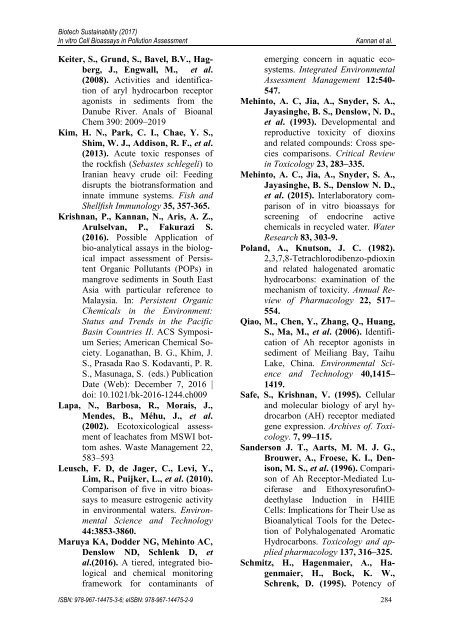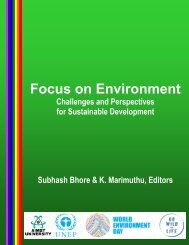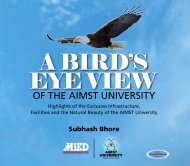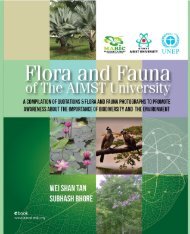Biotechnology for Sustainability: Achievements, Challenges and Perspectives
World Environment Day (WED) is a global annual event celebrated each year on June 5 to promote the awareness about the importance of preserving the environment. This book is published to commemorate the world environment day-2017 (WED-2017). The main purpose of this book is to highlight – how biotechnology can contribute for the sustainable development and in achieving sustainable development goals (SDGs) adapted by the international community to improve the health of people and planet? This book contains 38 full-length articles contributed by various researchers, scientists and academicians. A prudent use of biotechnology in the biodiversity conservation, environmental protection, and production of more and better quality of food, fiber, fuel and drugs will contribute in achieving SDGs and to promote the peace in the world. This book will serve as a reference to various researchers, scientists, academicians and students involved in biodiversity conservation, environmental protection and various fields of biology and biotechnology.
World Environment Day (WED) is a global annual event celebrated each year on June 5 to promote the awareness about the importance of preserving the environment. This book is published to commemorate the world environment day-2017 (WED-2017). The main purpose of this book is to highlight – how biotechnology can contribute for the sustainable development and in achieving sustainable development goals (SDGs) adapted by the international community to improve the health of people and planet? This book contains 38 full-length articles contributed by various researchers, scientists and academicians. A prudent use of biotechnology in the biodiversity conservation, environmental protection, and production of more and better quality of food, fiber, fuel and drugs will contribute in achieving SDGs and to promote the peace in the world. This book will serve as a reference to various researchers, scientists, academicians and students involved in biodiversity conservation, environmental protection and various fields of biology and biotechnology.
You also want an ePaper? Increase the reach of your titles
YUMPU automatically turns print PDFs into web optimized ePapers that Google loves.
Biotech <strong>Sustainability</strong> (2017)<br />
In vitro Cell Bioassays in Pollution Assessment<br />
Keiter, S., Grund, S., Bavel, B.V., Hagberg,<br />
J., Engwall, M., et al.<br />
(2008). Activities <strong>and</strong> identification<br />
of aryl hydrocarbon receptor<br />
agonists in sediments from the<br />
Danube River. Anals of Bioanal<br />
Chem 390: 2009–2019<br />
Kim, H. N., Park, C. I., Chae, Y. S.,<br />
Shim, W. J., Addison, R. F., et al.<br />
(2013). Acute toxic responses of<br />
the rockfish (Sebastes schlegeli) to<br />
Iranian heavy crude oil: Feeding<br />
disrupts the biotrans<strong>for</strong>mation <strong>and</strong><br />
innate immune systems. Fish <strong>and</strong><br />
Shellfish Immunology 35, 357-365.<br />
Krishnan, P., Kannan, N., Aris, A. Z.,<br />
Arulselvan, P., Fakurazi S.<br />
(2016). Possible Application of<br />
bio-analytical assays in the biological<br />
impact assessment of Persistent<br />
Organic Pollutants (POPs) in<br />
mangrove sediments in South East<br />
Asia with particular reference to<br />
Malaysia. In: Persistent Organic<br />
Chemicals in the Environment:<br />
Status <strong>and</strong> Trends in the Pacific<br />
Basin Countries II. ACS Symposium<br />
Series; American Chemical Society.<br />
Loganathan, B. G., Khim, J.<br />
S., Prasada Rao S. Kodavanti, P. R.<br />
S., Masunaga, S. (eds.) Publication<br />
Date (Web): December 7, 2016 |<br />
doi: 10.1021/bk-2016-1244.ch009<br />
Lapa, N., Barbosa, R., Morais, J.,<br />
Mendes, B., Méhu, J., et al.<br />
(2002). Ecotoxicological assessment<br />
of leachates from MSWI bottom<br />
ashes. Waste Management 22,<br />
583–593<br />
Leusch, F. D, de Jager, C., Levi, Y.,<br />
Lim, R., Puijker, L., et al. (2010).<br />
Comparison of five in vitro bioassays<br />
to measure estrogenic activity<br />
in environmental waters. Environmental<br />
Science <strong>and</strong> Technology<br />
44:3853-3860.<br />
Maruya KA, Dodder NG, Mehinto AC,<br />
Denslow ND, Schlenk D, et<br />
al.(2016). A tiered, integrated biological<br />
<strong>and</strong> chemical monitoring<br />
framework <strong>for</strong> contaminants of<br />
Kannan et al.<br />
emerging concern in aquatic ecosystems.<br />
Integrated Environmental<br />
Assessment Management 12:540-<br />
547.<br />
Mehinto, A. C, Jia, A., Snyder, S. A.,<br />
Jayasinghe, B. S., Denslow, N. D.,<br />
et al. (1993). Developmental <strong>and</strong><br />
reproductive toxicity of dioxins<br />
<strong>and</strong> related compounds: Cross species<br />
comparisons. Critical Review<br />
in Toxicology 23, 283–335.<br />
Mehinto, A. C., Jia, A., Snyder, S. A.,<br />
Jayasinghe, B. S., Denslow N. D.,<br />
et al. (2015). Interlaboratory comparison<br />
of in vitro bioassays <strong>for</strong><br />
screening of endocrine active<br />
chemicals in recycled water. Water<br />
Research 83, 303-9.<br />
Pol<strong>and</strong>, A., Knutson, J. C. (1982).<br />
2,3,7,8-Tetrachlorodibenzo-pdioxin<br />
<strong>and</strong> related halogenated aromatic<br />
hydrocarbons: examination of the<br />
mechanism of toxicity. Annual Review<br />
of Pharmacology 22, 517–<br />
554.<br />
Qiao, M., Chen, Y., Zhang, Q., Huang,<br />
S., Ma, M., et al. (2006). Identification<br />
of Ah receptor agonists in<br />
sediment of Meiliang Bay, Taihu<br />
Lake, China. Environmental Science<br />
<strong>and</strong> Technology 40,1415–<br />
1419.<br />
Safe, S., Krishnan, V. (1995). Cellular<br />
<strong>and</strong> molecular biology of aryl hydrocarbon<br />
(AH) receptor mediated<br />
gene expression. Archives of. Toxicology.<br />
7, 99–115.<br />
S<strong>and</strong>erson J. T., Aarts, M. M. J. G.,<br />
Brouwer, A., Froese, K. I., Denison,<br />
M. S., et al. (1996). Comparison<br />
of Ah Receptor-Mediated Luciferase<br />
<strong>and</strong> EthoxyresorufinOdeethylase<br />
Induction in H4IIE<br />
Cells: Implications <strong>for</strong> Their Use as<br />
Bioanalytical Tools <strong>for</strong> the Detection<br />
of Polyhalogenated Aromatic<br />
Hydrocarbons. Toxicology <strong>and</strong> applied<br />
pharmacology 137, 316–325.<br />
Schmitz, H., Hagenmaier, A., Hagenmaier,<br />
H., Bock, K. W.,<br />
Schrenk, D. (1995). Potency of<br />
ISBN: 978-967-14475-3-6; eISBN: 978-967-14475-2-9 284







